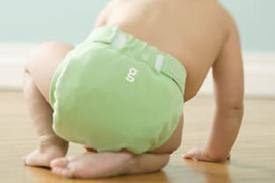Did You Know?

I've gotten asked quite a few times why we have chosen cloth diapering for our new little one so I thought I would share with you some of the reasons here. For us it is a combo of economical, financial, and preference. However, after doing some research, the answer for us was clear. Here are some facts that helped us decide to become a cloth diaper family:
- Disposables leave behind an average of 2.7 tons of non-biodegradable waste (not to mention the waste produced by manufacturing them alone) per child.
-With disposables, some estimate you spend an average of $2000 per child. Cloth compares at only an average of $150-$350 per child (with the added but minimal cost of electricity and water to launder them).
-It's a little-known fact that cloth diaper children potty train earlier, and with less effort on their parent's part. This has mostly to do with the fact that when a cloth diaper is wet, they can feel the sensation.
-Disposable diapers contain traces of Dioxin, an extremely toxic by-product of the paper-bleaching process. It is a carcinogenic chemical, listed by the EPA as the most toxic of all cancer-linked chemicals. It is banned in most countries, but not the U.S.
-Disposable diapers contain Tributyl-tin (TBT) - a toxic pollutant known to cause hormonal problems in humans and animals.
-Disposable diapers contain sodium polyacrylate, a type of super absorbent polymer (SAP), which becomes a gel-like substance when wet. A similar substance had been used in super-absorbency tampons until the early 1980s when it was revealed that the material increased the risk of toxic shock syndrome by increasing absorbency and improving the environment for the growth of toxin-producing bacteria.
-The instructions on a disposable diaper package advise that all fecal matter should be deposited in the toilet before discarding, yet less than one half of one percent of all waste from single-use diapers goes into the sewage system.
-No one knows how long it takes for a disposable diaper to decompose, but it is estimated to be about 250-500 years, long after your children, grandchildren and great, great, great grandchildren will be gone.
-Disposable diapers are the third largest single consumer item in landfills, and represent about 4% of solid waste. In a house with a child in diapers, disposables make up 50% of household waste.
-Disposable diapers generate sixty times more solid waste and use twenty times more raw materials, like crude oil and wood pulp.
-The manufacture and use of disposable diapers amounts to 2.3 times more water wasted than cloth.
(Sources of info mainly from this this article).
-Cloth diapers are no longer your mother's or grandmother's cloth diapers: no pins, no baggy cloths hanging, no blowout mess. They are designed to be as easy to use as a disposable these days.
For us it's a clear choice. And with the ability to stay home with my baby, it's an easy choice. A couple extra loads of laundry a week for a solution that makes sense for us. We've selected the brands of cloth diapers that we will be using and are hoping to purchase them after our baby shower. XO, Meg



Good for you, Meg! We're going to try to go this direction as well. Have you picked a type/company you'll be using yet? I find the research in that area a little overwhelming myself. :o)
ReplyDeleteI'll send you a message with some more info!
ReplyDelete